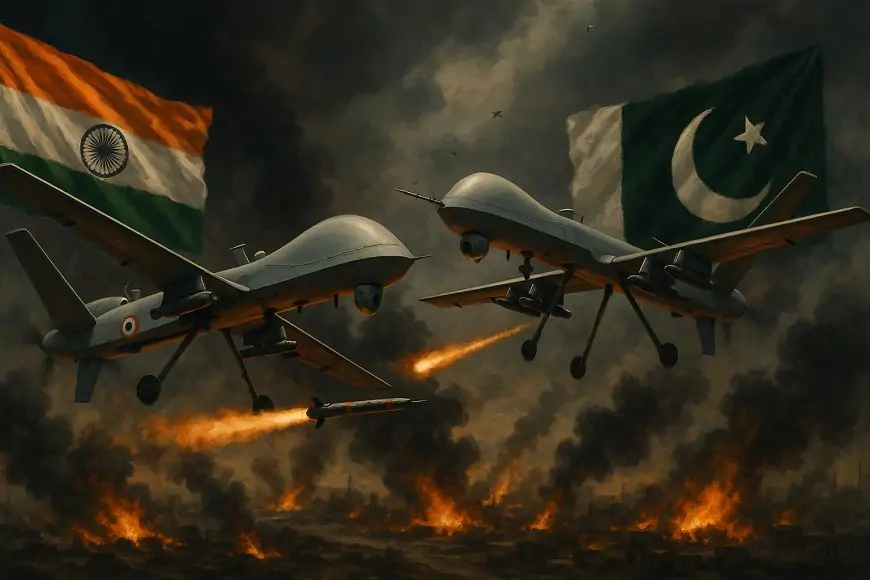Intensified India-Pakistan Drone Warfare

The ongoing conflict between India and Pakistan has reached a perilous juncture, with drone warfare emerging as a central element in their military engagements. The recent escalation, marked by a series of cross-border drone and missile strikes, has not only intensified hostilities but also raised significant concerns about regional stability and the potential for a broader conflict.
Background: The Catalyst for Conflict
The immediate trigger for the current escalation was the terrorist attack in Pahalgam, Indian-administered Kashmir, which resulted in the deaths of 26 individuals, including 25 Hindu tourists and one local resident. India attributed the attack to Pakistan-based militants, a claim that Islamabad vehemently denied. In retaliation, India launched "Operation Sindoor," targeting nine sites in Pakistan and Pakistan-administered Kashmir, which it described as terrorist infrastructure .
Pakistan condemned the strikes as violations of its sovereignty and responded by downing 25 Indian drones and missiles, including Israeli-made Harop loitering munitions. The Pakistani military also claimed to have shot down five Indian fighter jets, although India disputed these claims .
The Role of Drone Warfare
Drones have become a pivotal tool in modern warfare, offering precision strikes with reduced risk to personnel. Both India and Pakistan have developed and deployed advanced unmanned aerial vehicles (UAVs) for surveillance, reconnaissance, and offensive operations.
India's recent use of the S-400 missile system, known as "Sudarshan," marked its first combat deployment, successfully intercepting incoming Pakistani missiles and drones . Conversely, Pakistan's Shahpar-III drone, a medium-altitude long-endurance UAV, has been showcased as a significant advancement in its aerial capabilities .
The reliance on drones has led to a high-stakes aerial standoff, with both nations accusing each other of violating airspace and targeting civilian areas. For instance, an Indian missile strike reportedly damaged a mosque-seminary in Muzaffarabad, Pakistan-administered Kashmir, resulting in civilian casualties
Escalation and International Concerns
The exchange of drone and missile strikes has resulted in significant casualties on both sides. Pakistan reported at least 31 civilian deaths and numerous injuries, while India acknowledged casualties from Pakistani shelling in Poonch .
The situation has drawn international concern, with global leaders urging restraint. Former U.S. President Donald Trump expressed a desire to mediate and help resolve the situation, emphasizing the need for de-escalation .
The potential for a full-scale war remains a pressing issue, with both nations possessing nuclear arsenals. Pakistan's Defense Minister Khawaja Asif warned that the threat of nuclear conflict is "clear and present," highlighting the catastrophic consequences of further escalation .
Civil Defense and Preparedness
In response to the heightened threat, India conducted a nationwide civil defense exercise on May 7, 2025, named "Operation Abhyaas." The drill spanned 244 districts, including major cities like Delhi, Mumbai, and Hyderabad, and involved testing air raid sirens, readying bomb shelters, simulating blackouts, and training civilians in emergency response procedures
The exercise aimed to bolster civilian readiness against potential hostile threats, particularly in light of the recent Pahalgam attack. The Indian government emphasized the importance of national security and preparedness in the face of escalating tensions.
Conclusion
The intensification of drone warfare between India and Pakistan represents a significant development in their longstanding conflict. While drones offer strategic advantages, their use in densely populated regions raises serious ethical and humanitarian concerns. The current escalation underscores the urgent need for diplomatic engagement and conflict resolution to prevent further loss of life and to maintain regional stability.
As both nations continue to navigate this complex and volatile situation, the international community's role in facilitating dialogue and promoting peace remains crucial. The hope is that through concerted diplomatic efforts, the path to de-escalation and lasting peace can be achieved.(




















